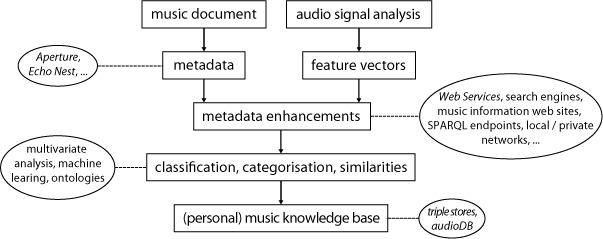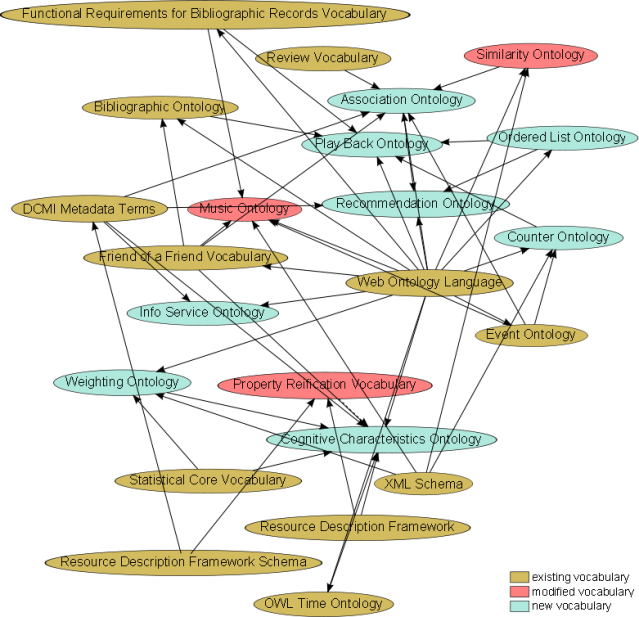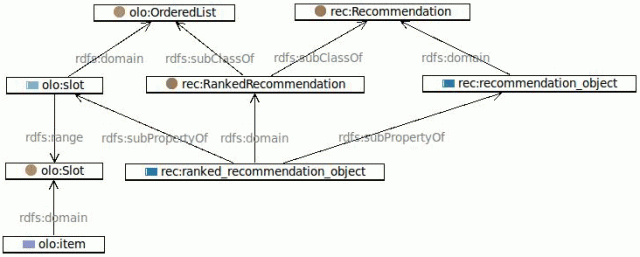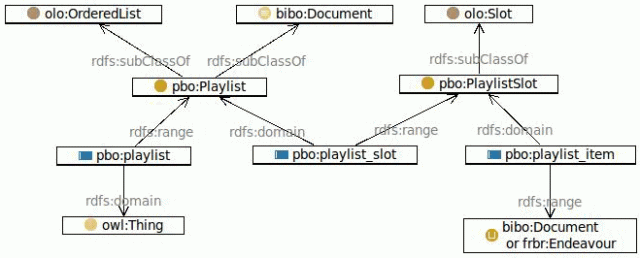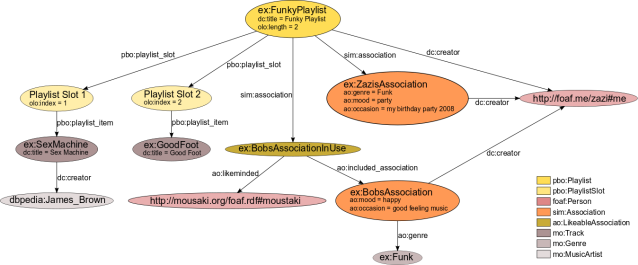Hello everybody,
it’s time to announce the Cognitive Characteristics Ontology 😉
Currently, several approaches regarding interests representation exist in form of separate Semantic Web Ontologies, e.g. the Weighted Interest Vocabulary, the e-foaf:interest Vocabulary or the Interest Mining Ontology. Each of the mentioned approaches is somehow aligned to the interests modelling concept of the FOAF Vocabulary.
Due to that reason, I decided to merge all these interest related ontologies under one hood , model some concepts properly and add useful extensions. This ontology alignment process is strongly influenced by the outcome of the User (weighted) Interests Ontology working group from Hypios VoCamp Paris 2010. The result of this task was the Weighted Interests Vocabulary 0.5. However, the range of that ontology is still a bit limited, because it provides “only” basic concepts and properties for describing preferences (interests) within contexts, their temporal dynamics and their origin.
That’s why, I built the Cognitive Characteristics Ontology on top of the latest revision of the Weighted Interests Vocabulary to broaden the scope to be able to model cognitive patterns. That means all concepts and properties are imported from this ontology. Some of them are also redefined and renamed to broaden their meaning. Furthermore, the Cognitive Characteristics Ontology is inspired by the Unified User Context Model, the General User Model Ontology, the User Modelling for Information Retrieval Language (UMIRL) and all their fundamental sources, and finally, the discussions on the FOAF developers mailing list.
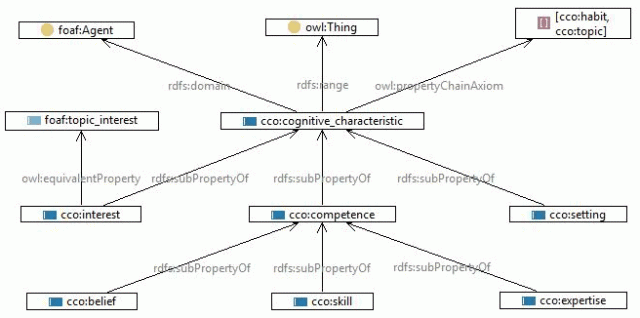
The Cognitive Characteristics Ontology includes two opportunities to model cognitive patterns. The first one is the representation of cognitive characteristics by using the semantic relation cco:cognitive_characteristic or better its more specialised sub properties (see the graphic above) to associate the topics of the cognitive patterns to the users. The second opportunity is the
object-oriented context reification of cco:cognitive_characteristic, cco:CognitiveCharacteristic, which is a general multiple purpose cognitive characteristic concept to describe cognitive patterns more in detail for a specific user or user group.
As one can see in the graphic above, the specialised sub properties of cco:cognitive_characteristic, the cognitive patterns, currently are
- interest (cco:interest), that means, a certain area of interest or preference, which is equivalent to foaf:topic_interest,
- compentence (cco:competence), that means, the compentence to (be able to) do or know something or
- setting (cco:setting), often regarding a specific environment, e.g. an application.
One can also refine the semantic relation of a competence association by using the sub properties of cco:competence, which are currently:
- cco:skill: the ability or skill to (be able to) do something, e.g. to walk, to play the piano or to work in a team
- cco:expertise: the knowledge or expertise in a certain domain or a specific topic, e.g. football, programming languages or music
- cco:belief: an uncertain relation for competence representation, that means beliefs, persuasions or opinions, which can also be misconceptions

One can see the second opportunity to model cognitive patterns, cco:CognitiveCharacteristic in the graphic above (or here for an extended version). This concept can be used to associate any foaf:Agent instance to (a) cco:CognitiveCharacteristic instance(s) with help of the properties cco:habit and cco:agent. The topics of a cco:CognitiveCharacteristic instance are related to it by using the property cco:topic, so that a property chain of cco:habit and cco:topic will also direct to topics of a cognitive pattern of an user or user group. That means, a statement that is modelled with the simple semantic relation approach based on cco:cognitive_characteristic can also be represented by an instance of cco:CognitiveCharacteristic, which has a cco:agent or cco:habit, a cco:topic and a cco:characteristic relation. The last property in this row is used to associate the applied cognitive pattern relation (sub properties of cco:cognitive_characteristic).
Different statistics can be made on cognitive characteristics. These are currently:
- cco:overall_weight, which reflects the overall interest in a topic and should be different from the actual weight (associated by the property wo:weight) of a cognitive characteristic
- cco:longest_duration, which is the longest continuous interval of attention for a cognitive pattern
- cco:ultimative_duration, which is the overall duration of attention for a cognitive pattern
Besides these statistics, one can also associate a concrete activity (by using the property cco:activity), to differentiate e.g. between football playing (topic = football; activity = playing) and football watching (topic = football; activity = watching), and further statistical items (by using the property cco:statistical_item) to a cognitive pattern description, which is itself also a sub class of scovo:Item.
It is also important, to be able to describe dynamics of a cognitive characteristic. In the Cognitive Characteristics Ontology they can be described with help of the cco:CharacteristicDynamics concept, which is a sub class of wo:Weight, and can be related to a cco:CognitiveCharacteristic instance by using the property cco:characteristic_dynamics. Thereby, one can relate
- concrete appear times (time instants or intervals, by using the property cco:appear_time), when a cognitive pattern gets attention by someone, or
- an evidence description (by using the property cco:evidence), where this characteristic or dynamics was derived from.
to a cco:CognitiveCharacteristic or cco:CharacteristicDynamics instance.
Below are two use case examples modelled with help of the Cognitive Characteristics Ontology. The first one describes a part of an user profile as it can be taken from an user account of a personal music knowledge base and the second one an user profile example with different cognitive characteristics of the same topic.
@prefix foaf: <http://xmlns.com/foaf/0.1/> .
@prefix cco: <http://purl.org/ontology/cco/core#> .
@prefix wo: <http://purl.org/ontology/wo/core#> .
@prefix days: <http://ontologi.es/days#> .
@prefix tl: <http://perl.org/NET/c4dm/timeline.owl#> .
@prefix xsd: <http://www.w3.org/2001/XMLSchema#> .
@prefix ex: <http://example.org/> .
@prefix rdf: <http://www.w3.org/1999/02/22-rdf-syntax-ns#> .
@prefix rdfs: <http://www.w3.org/2000/01/rdf-schema#> .
@prefix owl: <http://www.w3.org/2002/07/owl#> .
@prefix dc: <http://purl.org/dc/elements/1.1/> .
@prefix cv: <http://kaste.lv/~captsolo/semweb/resume/cv.rdfs#> .
@prefix cvbase: <http://kaste.lv/~captsolo/semweb/resume/base.rdfs#> .
@prefix countries: <http://www.daml.org/2001/09/countries/countries.daml#> .
@prefix sim: <http://purl.org/ontology/similarity/> .
@prefix ao: <http://purl.org/ontology/ao/core#> .
ex:APerson
a foaf:Person , cv:Person ;
foaf:name "John White" ;
foaf:birthday "1974-07-09"^^xsd:date ;
foaf:gender "male" ;
cv:hasCitizenship countries:US ;
cco:skill <http://dbpedia.org/resource/Piano> ;
cco:skill <http://dbpedia.org/resource/Vocal> ;
cco:expertise <http://dbpedia.org/resource/Music> ;
cco:interest <http://dbpedia.org/resource/Category:Classical_music> ;
cco:interest <http://dbpedia.org/resource/Category:Blues> ;
cco:interest <http://dbpedia.org/resource/Category:Pop_music> ;
cco:interest <http://dbpedia.org/resource/Category:Rock_music> ;
cco:interest <http://dbpedia.org/resource/Wolfgang_Amadeus_Mozart> ;
cco:interest <http://dbpedia.org/resource/The_Beatles> ;
cco:interest <http://dbtune.org/musicbrainz/resource/signal/8aefa373-2858-4643-b691-cad4ac7c971a> ;
cco:interest ex:IdiosyncraticGenre1 ;
cco:interest ex:IdiosyncraticGenre2 ;
cco:habit [
a cco:CognitiveCharacteristic ;
cco:topic <http://dbpedia.org/resource/Piano> ;
cco:characteristic cco:skill ;
wo:weight [
a wo:Weight ;
wo:weight_value 6.0 ;
wo:scale ex:AScale
] ;
cco:activity <http://sw.opencyc.org/concept/Mx4rvVjUJ5wpEbGdrcN5Y29ycA>
] ;
cco:habit [
a cco:CognitiveCharacteristic ;
cco:topic <http://dbpedia.org/resource/Vocal> ;
cco:characteristic cco:skill ;
wo:weight [
a wo:Weight ;
wo:weight_value 7.0 ;
wo:scale ex:AScale
] ;
cco:activity <http://dbpedia.org/resource/Category:Singing>
] ;
cco:habit [
a cco:CognitiveCharacteristic ;
cco:topic <http://dbpedia.org/resource/Music> ;
cco:characteristic cco:expertise ;
wo:weight [
a wo:Weight ;
wo:weight_value 0.0 ;
wo:scale ex:AScale
] ;
] ;
cco:habit [
a cco:CognitiveCharacteristic ;
cco:topic <http://dbpedia.org/resource/Category:Classical_music> ;
cco:characteristic cco:interest ;
wo:weight [
a wo:Weight ;
wo:weight_value 7.0 ;
wo:scale ex:AScale
] ;
] ;
cco:habit [
a cco:CognitiveCharacteristic ;
cco:topic <http://dbpedia.org/resource/Category:Blues> ;
cco:characteristic cco:interest ;
wo:weight [
a wo:Weight ;
wo:weight_value 9.0 ;
wo:scale ex:AScale
] ;
] ;
cco:habit [
a cco:CognitiveCharacteristic ;
cco:topic <http://dbpedia.org/resource/Category:Pop_music> ;
cco:characteristic cco:interest ;
wo:weight [
a wo:Weight ;
wo:weight_value 5.0 ;
wo:scale ex:AScale
] ;
] ;
cco:habit [
a cco:CognitiveCharacteristic ;
cco:topic <http://dbpedia.org/resource/Category:Rock_music> ;
cco:characteristic cco:interest ;
wo:weight [
a wo:Weight ;
wo:weight_value 8.0 ;
wo:scale ex:AScale
] ;
] ;
cco:habit [
a cco:CognitiveCharacteristic ;
cco:topic ex:IdiosyncraticGenre2 ;
cco:characteristic cco:interest ;
wo:weight [
a wo:Weight ;
wo:weight_value 7.0 ;
wo:scale ex:AScale
] ;
cco:appear_time [
a days:WeekdayInterval ;
dc:title "bedtime" ;
tl:at "23:00:00"^^xsd:time
] ;
] .
ex:ACV
a cv:CV ;
cv:aboutPerson ex:APerson ;
cv:hasEducation [
a cv:Education ;
cv:degreeType cvbase:EduMaster
] ;
cv:hasWorkHistory ex:AWorkHistory .
ex:AWorkHistory
a cv:WorkHistory ;
cv:careerLevel cvbase:Student .
ex:tempo
a rdf:Property , owl:DatatypeProperty ;
rdfs:range xsd:string ;
rdfs:subPropertyOf ao:context .
ex:IdiosyncraticGenre1
a sim:Association ;
dc:title "happy music" ;
ao:genre <http://dbpedia.org/resource/Category:Pop_music> ;
ex:tempo "allegro" ;
ao:mood "happy" .
ex:IdiosyncraticGenre2
a sim:Association ;
dc:title "romantic music" ;
ex:tempo "largo" .
ex:AScale a wo:Scale ;
wo:min_weight 0.0 ;
wo:max_weight 9.0 ;
wo:step_size 1.0 .
This example above shows a part of an user profile as it can be taken from an user account of a personal music knowledge base. It is inspired by an example that was originally modelled with UMIRL (see here) and now remodelled with more expressiveness with help of the Cognitive Characteristics Ontology. The user profile is from the person John White, who can play the piano and sing by having no education in music. Furthermore, he is interested in several music genres, the music artist Wolfgang Amadeus Mozart, the music group the Beatles, the music song “Yesterday” from the Beatles and some self-defined idiosyncratic music genres.
At the beginning, all cognitive patterns of this user are described by simple semantic relations, which are sub properties of cco:cognitive_characteristic. Thereby, the most of the topics of the cognitive characteristic relations are information resources from the information service DBPedia and one topic is a information resource from DBTune. Afterwards, some of these shortcut relations are described more in detail with help of cco:CognitiveCharacteristic instances.
Each of these cognitive characteristic descriptions is related to a weighting with a different weight value (related by wo:weight_value) and the same scale (related by wo:scale). Due to these weightings, we can conclude that John White can sing and play the piano quite good. However, he has no knowledge in musical foundations. Furthermore, a cco:CognitiveCharacteristic instance is associated with a topic (by cco:topic) of a shortcut relation and a property (by cco:characteristic) of such a relation. Besides these information some of them are also related with an activity (associated by cco:activity), which are information resources from OpenCyc (playing a musical instrument) or DBPedia (singing).
This user profile example includes especially detailed descriptions of John White’s interest in specific music genres. Thereby, we can conclude (besides other things) that he is a big fan of Blues and Rock music and quite interested in romantic music (ex:IdiosyncraticGenre2). The last music genre is defined as music context, which he prefers weekdays (represented by days:WeekdayInterval) at “bedtime” (ca. 11 pm). This idiosyncratic genre is itself defined as a sim:Association instance, which is titled as “romantic music” and should be very slow (largo, associated by ex:tempo as sub property of ao:context).
@prefix foaf: <http://xmlns.com/foaf/0.1/> .
@prefix cco: <http://purl.org/ontology/cco/core#> .
@prefix wo: <http://purl.org/ontology/wo/core#> .
@prefix ex: <http://example.org/> .
ex:APerson
a foaf:Person ;
foaf:name "John Wayne" ;
cco:skill <http://dbpedia.org/resource/Football_(soccer)> ;
cco:expertise <http://dbpedia.org/resource/Football_(soccer)> ;
cco:interest <http://dbpedia.org/resource/Football_(soccer)> ;
cco:habit [
a cco:CognitiveCharacteristic ;
cco:topic <http://dbpedia.org/resource/Football_(soccer)> ;
cco:characteristic cco:skill ;
wo:weight [
a wo:Weight ;
wo:weight_value 6.0 ;
wo:scale ex:AScale
] ;
cco:activity <http://sw.opencyc.org/concept/Mx4rwJRiEpwpEbGdrcN5Y29ycA>
] ;
cco:habit [
a cco:CognitiveCharacteristic ;
cco:topic <http://dbpedia.org/resource/Football_(soccer)> ;
cco:characteristic cco:expertise ;
wo:weight [
a wo:Weight ;
wo:weight_value 7.0 ;
wo:scale ex:AScale
] ;
] ;
cco:habit [
a cco:CognitiveCharacteristic ;
cco:topic <http://dbpedia.org/resource/Football_(soccer)> ;
cco:characteristic cco:interest ;
wo:weight [
a wo:Weight ;
wo:weight_value 5.0 ;
wo:scale ex:AScale
] ;
cco:activity <http://sw.opencyc.org/concept/Mx4rwO0J55wpEbGdrcN5Y29ycA>
] .
ex:AScale a wo:Scale ;
wo:min_weight 0.0 ;
wo:max_weight 9.0 ;
wo:step_size 1.0 .
This user profile example above, with different cognitive characteristics of the same topic, represents the person John Wayne, who has tree different cognitive patterns – a skill (cco:skill), an expertise (cco:expertise) and an interest (cco:interest) – with the topic soccer. At the beginning, each semantic relation is modelled as shortcut relation. Afterwards, follow more detailed descriptions of these three cognitive characteristics, which are associated to John Wayne by using the property cco:habit. Each of these cco:CogntiveCharacteristic instances include, besides the basis information of the shortcut relations, also a weight description and two of them, furthermore, an activity relation (associated by cco:activity).
So that a reasoning engine is now not only able to automatically infer the knowledge from the shortcut relations now, but rather then also from the reification class instances. That means, one can conclude that John Wayne
Such a modelling has the advantage that one can talk about one and the same topic, independently of the activities that are related to cognitive pattern descriptions of a person. This is possible, because activity, cognitive characteristic and topic have their own, separate dimension.
As one can see the by the two use case examples above, the expressivity of the Cognitive Characteristics Ontology is manifold. More examples are available in the examples section of the specification documention.
I would like to thank very much the creators of the different interest ontologies, where this multiple purpose cognitive charateristics ontology is based on. That means, Dan Brickley, Dave Reynolds, Libby Miller, Toby Inkster, Yi Zeng, Yan Wang, Danica Damljanovic, Zhisheng Huang, Alexandre Passant, Sheila Kinsella and John Breslin. Furthermore, the creators of the Unified User Context Model, of the General User Model Ontology, of the User Modelling for Information Retrieval Language and all their fundamental sources, and finally, the people from the FOAF developers mailing list, especially Nima Dokoohaki. Please feel free to reuse and extend the Cognitive Characteristics Ontology also for your own projects (let me know your use cases 😉 ). Comments, suggestions and critics are also very welcome.
Cheers,
Bob


